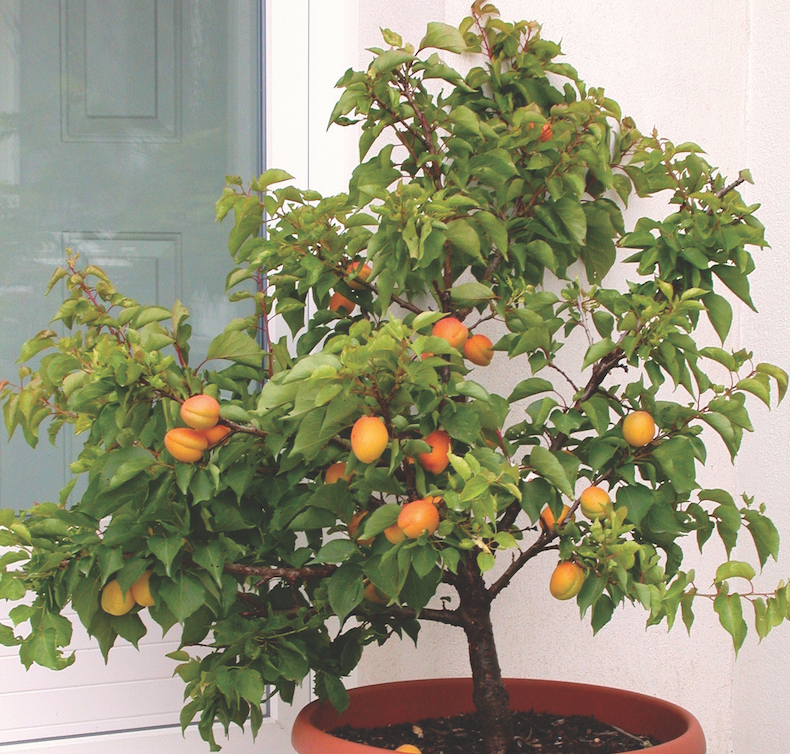
How to prune patio fruit trees
Even if you don’t have a huge garden, many fruit trees can be successfully grown as patio plants in pots. A dwarf rootstock is used to ensure that the trees don’t get too big, making them ideal for containers.
During the early years a light tidy up is all that’s required until your fruit tree reaches the required size. After that, pruning a dwarf tree follows the same guidelines as their traditional sized counterparts.
Here’s how to prune your patio fruit trees to ensure they have a long and healthy life...
How to prune dwarf apple and pear trees

This mini 'Golden Delicious' apple tree makes great use of space
Copyright: Visions BV, Netherlands
Dwarf apple and pear trees should be pruned between November and early March when they’re dormant:
- Begin by removing any dead, diseased or weak growth as well as any branches that are crossing. Try to create a clean, open framework.
- On spur-bearing trees (those which produce fruit on short shoots on older wood) reduce the length of the main branches by about a third.
- Cut to a good, outward-facing bud, making a slanted cut down and away from the bud to prevent rain pooling on it.
- Remove any growth crowding the centre of the tree to allow better air circulation and more light.
- On established trees, thin any congested fruit spurs.
- Start with those on the underside of branches as this fruit will struggle to ripen.
- Shorten others, leaving just the strongest so there’s plenty of space for developing fruit.
- On tip-bearing trees, stop branches getting too long by cutting back some of the older stems to a younger shoot.
How to prune dwarf plum, sweet cherry, apricot and peach trees

Prune dwarf apricot trees in late spring
Image: Apricot 'Aprigold'® (patio) from Thompson & Morgan
Stone fruit trees like dwarf plums, cherries, apricots and peaches grown in containers need little pruning. The guiding principle should be to remove dead, diseased or weak growth and ensure that branches are not crossing.
If you do need to cut them back, wait until late spring to prune apricots or peaches, and leave cherries and plums until summer to prevent infections such as silver leaf or canker.
We hope you've enjoyed this article and you now know how to properly care for your patio fruit trees. If you have regular-sized fruit trees that need maintaining, visit comprehensive hub page for more information and expert fruit trees advice. Or if you're interested primarily in container-sized plants, learn from our patio plants guides.
See all pruning guides
Individual guides
Flower & Shrubs
- Pruning Buddleja
- Pruning Camellias
- Pruning Clematis
- Pruning Fuchsias
- Pruning Hydrangeas
- Pruning Hypercium - St Johns Wort
- Pruning Lavender
- Pruning Magnolias
- Pruning Passion Flowers
- Pruning Rhododendron
- Pruning Ribes Sanguineum
- Pruning Rosemary
- Pruning Roses
- Pruning Tree Peonies
- Pruning Wisteria
- Pruning Asparagus
- Pruning Blueberries
- Pruning Goji Berries
- Pruning Honeyberries
- Pruning Raspberries
- Pruning Apple trees
- Pruning Box and Yew trees
- Pruning Catalpa trees
- Pruning Christmas trees
- Pruning Olive trees
- Pruning Pear trees
- Pruning Plum trees
Fruit & Veg
Trees

Written by: Mandy Bradshaw, the Chatty Gardener
Cotswold-based Garden Media Guild member, Mandy Bradshaw, is also known as the Chatty Gardener. Passionate about gardening and writing, her beginnings are in football reporting for her primary school, and Mesembryanthemum planting with her mother. Winner of the 2018 Property Press Awards 'Garden Journalist of the Year', she writes for not only her own blog but also a range of newspapers, magazines and other gardening and non-gardening sites.Banner image: Simona Bottone / Shutterstock
Sign Up For Exclusive Special Offers




© 2024 Thompson & Morgan. All rights reserved. A division of Branded Garden Products Limited.



